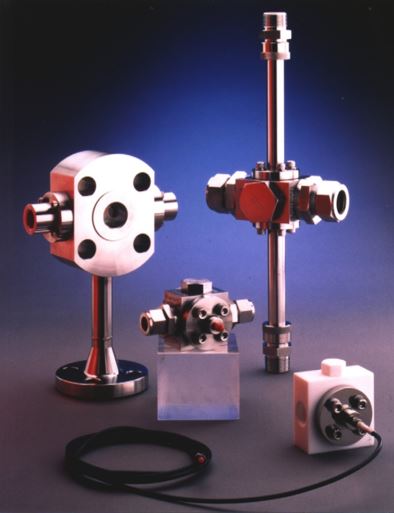
Analytical process measurement manufacturers have developed a variety of flow cells to address all types of application challenges. From metal intolerance, corrosive sample streams, to those involving extremely hazardous materials, there is a flow cell that has been specifically engineered to meet these requirements.
Exceptional Flow Cell Light Transmission
All the flow cells listed here have exceptional optical performance. This means more signal and lower measurement noise translating to lower limits of detection.
Transmission for Teflon Flow Cells
The peak transmission for the standard Teflon Flow Cell exceeds 50% and the Teflon PFA/PEEK Flow Cell is guaranteed to exceed 45%. Typically, the longer the path length the lower the transmission. However, where the Axial Flow Cell is concerned, its peak transmission exceeds 30% which is considerably higher than it’s competition.
Transmission for Metal Flow Cells
Like the other optical flow cells listed the metal flow cells all provide exceptional optical performance. Both the Multi-Purpose Flow Cell and the Heated version provide exceptional optical performance, typically exceeding peak transmissions of 50%. Where the Axial Flow Cell is concerned, its peak transmission exceeds 30% which is considerably higher than other brands on the market.
Teflon Flow Cell vs. Metal Flow Cell Construction
The Metal Flow Cells comes standard in 316L stainless steel but other alloys are available. Suitable o-ring materials must be specified to meet your process chemistry and safety requirements. Common materials, such as Viton, Kalrez®, EPDM, etc., are readily available.
Regarding the Teflon Flow Cells, since no metal parts come in contact with the liquid stream, the design is ideal for processes where even parts per billion levels of metals contamination can create serious problems as in semiconductor fabrication etching and cleaning steps.
A Simple, Serviceable Flow Cell Design
The flow cells listed here provide a convenient, compact, rugged sample interface, that is easy to install and even easier to service. The flow cell’s sapphire windows can be cleaned by simply removing a clean-out plug for direct access to the windows without disconnecting process lines or fiber optic cables.
If necessary, the flow cells can be completely disassembled for inspection or deep cleaning. The reassemble step is easily accomplished without changing the critical pathlength, an important feature when working with established NIR calibration models.
Common Integration with Most Spectrometers
Fiber optic systems configured with SMA 905 connectors can be fully integrated with any of the flow cells listed. Connecting the flow cell with fibers having a core diameter of 400 to 600 micron to the NIR analyzer will provide the best optical performance. Also for the best optimal performance, optically match the sample interface to both the spectrometer and the fiber optic cable when possible.
All flow cells recommended below are compatible with FT-NIR and dispersive analyzers. They have been manufactured to facilitate full integration with any fiber-optic spectrophotometer manufacturer. They are compatible with Guided Wave’s instruments, Bruker’s Matrix FT-NIR analyzer, ABB’s full line of FT-NIR spectrometers, and AIT’s optical analyzers.
Types of Teflon Flow Cells
For example, the Teflon Flow Cell, along with the PFA/PEEK Teflon Flow Cell and the Axial Teflon Flow Cell were all designed for sample streams that are either extremely corrosive or intolerant to metal contamination, as none of the cell’s wetted parts are constructed of metal.
Types of Metal Flow Cells
Whether you need to maintain the temperature of a preconditioned sample, have a process involving extremely hazardous materials, or need to achieve low levels of detection there is a metal flow cell to do the job. The high optical throughput and exceptional stability of the Multi-Purpose Flow Cell, Axial Flow Cell and High Safety Flow Cell can solve the toughest measurement issues when a flow cell is required.